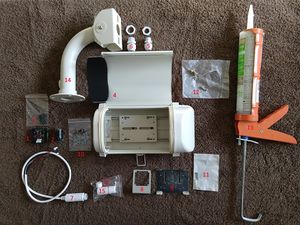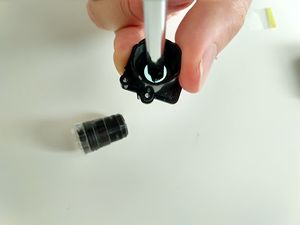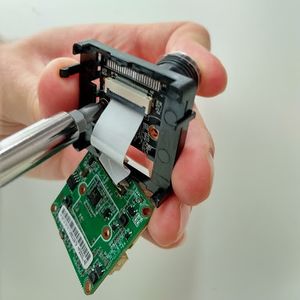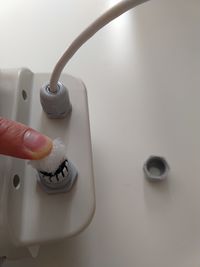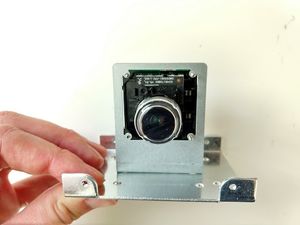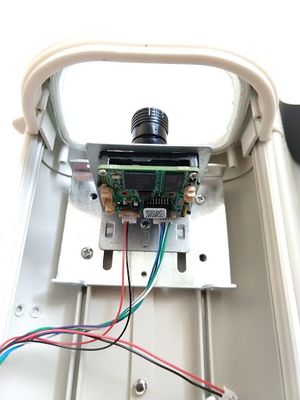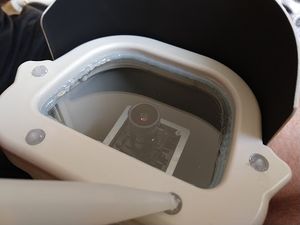Build A Camera
WORK IN PROGRESS PLEASE REFER TO GOOGLE DOC FOR NOW
Parts and Tools needed
Click on the image to the right to see a larger version with the parts labelled
- IMX291 sensor board
- Lens with the lens holder - 4mm, 6mm are M16 mount as pictured, while other lenses might be CS which have a different holder
- 2x M2 screws
- Camera housing
- Small cable gland
- Large cable gland
- Camera PoE cable (sometimes called a network cable by the sellers)
- Camera board holder
- Holder metal plate
- 3x M2 screws, 12 mm long
- 1x M3-.50 screws, 6mm long
- Metal plate screws supplied with the housing
- Transparent weatherproof silicone
- Housing mounting bracket
- Waterproof ethernet cable protector
- Pair of PoE adapters (not shown)
- 12V power supply for the camera (not shown)
The Camera, lens and camera PoE cable should be bought together. The camera housing, board holder, plate, cable glands and mounting bracket normally come together too, but you may need to ask the seller to include the camera board holder. The camera and housing can be bought from AliExpress though there may be other sources. Other items can be found in most hardware stores or your favorite online retailer.
You will also need small wire cutters and various size screwdrivers.
Finally, to test and focus the camera, you will need VLC. This software is preinstalled on the Pi but is also available for Mac, Windows or Linux from here.
Assembly
Preparing the lens
Start by removing protective covers from the sensor and lens. Take care not to touch the sensor after this!
The cameras come with an IR Block filter in the lens holder. We don't want this, so unscrew the lens from the holder and using a screwdriver, carefully punch out the filter from the front as shown in the image on the right. If it shatters, make sure there are no shards left.
Next look on the underside of the lens holder where you will see two plastic nubbins. These get in the way, so using the wire cutters snip them off.
Then screw the lens back into the lens holder.
Attaching the lens
Carefully unclip the circuit board from the plastic holder, but DO NOT detach the ribbon cable.
Using the supplied screws, attach the lens to the sensor board.
Now clip the circuit board back into the plastic housing.
Preparing the Camera Housing
Fit the small cable gland to the housing and pass the loose ends of the Camera PoE cable up through, but don't tighten it up yet.
Fit the large cable gland in the other opening, and push a piece of plastic packing foam into it.
This is to keep insects from getting in, but allow moisture out.
.
Attaching the Camera
Connect the metal camera holder to the metal plate using one 6mm M3 screw.
Then, using three 12 mm M2 screws, connect the camera board to the metal holder by passing the lens through the square hole.
Note that the writing on the camera board must be UPSIDE DOWN to get the correct orientation of the camera. In this orientation, the sockets for power and networking will be at the bottom of the rear of the camera board.
Finally, remove the plastic cap on the lens. See image for the proper camera board orientation, so the video is not sideways or upside down.
Installing the Camera in the Housing
Remove the plastic plate from inside the housing, we don't need this.
Fit the camera on its metal plate into the housing, as close to the front glass as you can get it without actually touching. A few millimetres away should be good.
Looking at the camera from the rear, attach the largest connector (the network) to the right hand socket.
Attach the power connector to the left hand socket. This connector has several pins but only two are connected.
The third connector is for a powered lens and is not used so tape it back out of the way.
Once you've secured the camera in position, you can tighten up the glands to hold the cables secure and sealed.
Testing and Focusing
At this point, your camera must be tested and focused. There's no point sealing up the housing and screwing it to the wall if its not focused !
Testing the Camera
Plug the "output" PoE adapter into the camera cable and plug a network cable into the PoE adapter. Plug the other end of the network cable into the "input" PoE adapter and attach the adapter into a spare socket on your home router. Connect the camera power supply to the power input of this PoE adapter and plug the power supply into the wall.
The Camera PoE cable lights should come on, indicating traffic is flowing. After a few seconds, it should steady down to irregular flashing.
If you don't see flashing lights then check the cable connections to make sure everything is plugged in properly.
The camera should now appear as a device on your network and to test it properly you will need to find its IP Address. Some routers will show you a list of connected devices, from which you should be able to identify the camera as a device called "LocalHost". Make a note of this address. If your router doesn't have this facility, there are many free pieces of software that can scan your network for IP addresses. Zenmap is one such.
Once you have the IP Address, open VLC on your Pi, Mac or Windows machine, and from the "Media" menu, select "Open Network Stream".
Enter the following into the address box, replacing your.camera.ip.address with the address you got earlier
rtsp://your.camera.ip.address:554/user=admin&password=&channel=1&stream=0.sdp
After a second or two, you should get a view through the camera. If nothing comes up, check you have got the right IP address, and that the cables are secure.
You can now double-check that you installed the camera the right way up. You should also close the housing case up and check if it can be seen obstructing the view anywhere. Move the camera around in the housing to minimise the obstructions, and if necessary bend the metal bracket forward a little.
However, dont worry if you can't eliminate all obstructions. Later on you will create a software mask to prevent these areas causing false detections.
Focusing the Camera
There's a whole separate section of the Wiki on focusing, but here's the short version
- connect the camera to your network as above.
- Open VLC.
- aim the camera at something at around 30-50 metres away.
- screw the lens in and out slowly to get best focus.
Note that there's a lag due to the network, so you should wait a second or two after each adjustment.
Sealing the Housing
Depending on your climate, its usually advisable to seal up the camera housing against rain and snow.
From the outside, carefully go round the edge of the glass with silicone sealant. Also squirt sealant into any screw holes visible on the front of the camera housing, where it will be most exposed to rain.
But DONT seal up the hinged door because you will occasionally need to maintain the camera, and you don't want to have to prise it open with a chisel!
Mounting Outside
Mount the camera somewhere with a good view of the sky and without too many 'terrestrial' obstructions such as trees, hills and buildings. Take special care to angle well away from security lights. These lights emit infrared and without the IR Block filter, the IMX cameras are extremely sensitive to this. Also bear in mind that you will need to be able to get to the camera to maintain it.
As before, don't worry if its not practical to eliminate all obstructions, as you can mask off any that can't be avoided.
Aiming the Camera
The cameras have a field of about 40-45 degrees vertically and 90 degrees horizontally. Best practice is to angle the camera upwards at between 35-45 degrees which should catch the most meteors. If you can arrange so that the camera view overlaps with other RMS users, thats even better. Check with the network to get an idea of a good direction
Thats it!
Once the camera is installed, connect up the PoE adapter, attach a long network cable and run it to wherever you are going to keep the Raspberry Pi. Remember to ask permission before drilling holes in the walls... :)
